Last updated on August 18, 2010
TROY LITTLE is one of the many maritimers carving their own path through animation. Geographically isolated from traditional media centers like Montreal, Toronto or Vancouver, the maritimes have found themselves the center of attention in the late 90s and early 2000s, becoming a new hotspot for Canadian animation production. While things may have taken a turn there, as has everywhere else, some animation artists have found their own way to navigate the turbulent tide. Troy Little is one of them. Nominated for an Eisner Award in 2010 for the ‘Best Publication For Teens’ category, this indie comics creator and full-time animation employee has managed to use his concept ‘Angora Napkin’, co-created with the multiply-talented Nick Cross, to leverage his way into the animated world as a creator after earning a berth in Teletoon’s Pilot Project. Canadian Animation Resources caught up with Troy via email before he departed for Toronto to participate in this year’s massive Toronto Comics Arts Festival (TCAF). All images © Troy Little. Click on images to enlarge.
WARREN LEONHARDT: Hey Troy, Thanks for making yourself available for this interview. And welcome to Canadian Animation Resources! Just by way of introduction, could you quickly outline your start in animation and comics? At what point do you decide to shift focus from one to the other?
TROY LITTLE: Thanks! I graduated from the Interpretive Illustration course at Sheridan in ’94 with the intent of using that as a solid basis to return and take the animation course. I never went back but ended up getting a job in animation nonetheless at Dynomight Cartoons in ’96 as a background artist. Over time I taught myself to work in different jobs, doing storyboards, design and animation.
After a year or two working in animation I began to get the itch to create something of my own that didn’t require a large collaborative process or a ton of money so I decided to make comics a side career. Cartoons and comics are what I was raised on; it’s not surprising I suppose to find me working in both fields. Ultimately I find making comics to be the most fulfilling of the two, but the least successful financially unfortunately.
WL: Was your relocation to the Maritimes professionally motivated or personal? How has it helped or hindered your career in light of how technology has changed the nature of the freelance business?
TL: Coming home to PEI was not a choice I made willingly. The animation studio I worked at tanked, owing me a ton of money. I tried not to look at returning home as a failure so much as a chance to re-group and re-assess things. I actually avoided working in animation for some time, opting to work in a hardware store or wait tables but eventually I came around and started working with Trapeze Animation in Charlottetown, PEI around 2005.
It’s been steady employment more or less since then with them and freelance work is hard to come by here, mostly due to the nature of the Canadian Tax Credits limiting my ability to work via remote for any other studios.
WL: Let’s get to your original IP and concept, ‘Angora Napkin’. How did it originate and in what form? Who got involved at that early stage and how?
TL: Angora Napkin started back around ’98 I think. Nick Cross and I were roommates and out of work at the time and decided “Hey, why don’t we make our own cartoon? Then we’d have a job and do something fun, rather then all these awful kiddie shows”. We were still fairly new to the animation industry and ignorant of the business side of things so we created this idea purely in a mindset of what we found to be funny and not necessarily what would fill a broadcaster time slot. To that extent we wrote a number of scripts, storyboards and concepts without any influence or restriction and really developed the show on our own.
We pitched it to the studio and they liked it up until someone claimed to find the name of the show somehow offensive. We were told to change it from Angora Napkin to something akin to “Bubblegum Pop” or “Rock Candy” but we instead opted to let it die then compromise the title that we thought was perfect. Besides, the studio hadn’t paid us a cent or even pitched it to a broadcaster to start making creative changes on all our hard work.
WL: At what point did you decide to take it farther and complete it as a graphic novel?
TL: By 2003 Nick had gone on to become a very talented short film animator while I had begun self-publishing my first comic series, Chiaroscuro. I remember, just before moving back to PEI having coffee with Nick in a Starbucks as asking him if he wouldn’t mind me doing something with Angora Napkin someday. He’d pretty much given up on the project but I loved the characters and wanted to have them live on in comics if not animation. So I made a few short back up Angora Napkin comics and published them in Chiaroscuro.
Around 2005 I finished work on the first Chiaroscuro graphic novel. As a “break” from the labor intensive crosshatching drama I decided to dust off Angora Napkin and make a one shot graphic novel as a segue between Chiaroscuro books. I figured that would take about a year, but it ended up taking three, as I became a Dad to twin girls at that time.
WL: What was your process in creating the graphic novel? For example, what mediums did you use? Did you write it on the fly as you drew it, or use a script? Did you use assistants at all, and how long did it take to complete?
TL: I’m a bit a purist when it comes to my comic work. It’s all pencils, paper and ink. For Chiaroscuro I work on 11X17 S172 Illustration board and ink with a Hunt 102 Crowqill. With Angora Napkin, I had to adapt to working on the fly (newborns and all that) so I worked on 10X14 pad of Bristol board I could carry in a kitbag with a Pentel Brush Pen.
I’ve generally developed my ideas for the story in my head over a long period of time so I know the flow and ending of the story along with the main points long before I put anything on paper. I’ll usually go to a coffee shop and start writing a script, mostly dialogue and work out a sequence. Then I’ll thumbnail out a few pages from there, adapting as I go. I like to keep the process organic, I find if I plan out too much ahead I’ll lose some of the excitement and energy. Also the time it takes to make comics allows for new ideas to pop up and that I can incorporate into the story.
The next step is roughing out the page in photocopy paper, working out a pretty tight layout with blue Col Erase and HB Pencils, which I’ll then transfer to good paper. I’ll tighten up the pencils then hand letter and ink everything. Then it’s a matter of scanning and colouring (if any is to be done) in Photoshop. At best a page of Chiaroscuro can take 14-18 hours to do while Angora Napkin 8-10 from thumbnails to final ink, but I never have that much time sequentially so I have to spread that out and pages can sometimes take weeks to finish in little chunks of time.
WL: At what point did IDW get involved with the project? Why did you choose them over other options?
TL: As much as I love self-publishing I couldn’t afford to keep it up after 7 issues of Chiaroscuro. My goal was to have 10 books collected to make up the first graphic novel so I just kept on drawing after that last print issue came out, hoping someday I’d figure out a way to get the book out there.
I received a PEI Council of the Arts Grant to complete the book and made a 100 copy POD (Print On Demand) run of the graphic novel and sent it to publishers, reviewers and comic professionals. The only real response I got was a positive review from Dave Sim (Cerebus) on his blog. Dave was a HUGE inspiration for my doing comics at all and is an obvious source of inspiration for my style on Chiaroscuro, so this in and of itself was a great moment for me.
After the blog review, I received an email from Ted Adams, the President of IDW (and a Cerebus fan himself) asking to see the book. Oddly enough I had sent IDW a copy of the book moths ago but it had apparently never made it to them. Needless to say I had another to them as quickly as I could.
Ted was very receptive to Chiaroscuro and subsequently Angora Napkin for publication. In my opinion IDW puts out some very fine books with high production values, so for me I couldn’t be happier with them and haven’t considered looking elsewhere as I’ve developed a very good and easy working relationship with them.
WL: After ‘Angora’ came out to some successful results and acclaim, you took it to Teletoon’s call for submissions. How did you repackage it for the pitching process and can you talk a bit about the pitch process?
TL: It wasn’t so much a repackage of the idea to fit animation as it was a return to it’s original conception. Very little actually changed, and in some instances appeared very much as it did when Nick and I first developed Angora Napkin as an animated series, albeit a little more polished.
I suppose I’ve always been trying to have Angora Napkin in both mediums and it was a matter of synchronicity that the call for the Teletoon Pilot Project came about while IDW was publishing the book. With all that material to present we teamed up with Mugisha Enterprises in PEI and our producer Wendy Errington in Toronto pitched the show for us. We lucked out and were selected out of over 200 applications to have our show turned into a pilot!
WL: Why did you choose Teletoon over another network like YTV, Cartoon Network or Nickelodeon, or rather than taking it to MIPCOM to shop it around?
TL: It’s kind of just how it worked out with the call for original Canadian content. We were pleased too that it was targeted at a late night audience and so we didn’t have to “clean it up”. It’s still up in the air whether or not Teletoon will take it to series, but if not we’ll shop it around, I’m sure it’ll find a good home somewhere.
WL: Can you outline your impression of Teletoon’s submission process? Was it complex/easy/confusing? Did you retain IP rights or sign them over for a set period of time?
TL: We had very little to do with it really. Reading over all the long form documents at trying to decipher the cryptic legal-speak is always tiresome but in the end we signed on to develop the pilot with them. We made sure we retained the IP rights to Angora Napkin for other mediums so we could continue making comics and such.
WL: Did IDW’s involvement convince Teletoon’s development execs to take a chance on ‘Angora’? What do you think helped sell them on the idea? Was there a lot of censorship from their side, given the sex drive of some of the female characters?
TL: I can’t say for sure that having IDW publishing a version of the property we were pitching them convinced them of anything, but I can only assume it helped. I heard “unofficially” that our show was hotly contested but also one of the most original they came across in their search.
The issue of censorship was actually quite funny. They asked us if we could up the sex and violence! I never EVER thought I’d hear the day a broadcaster would say that to me. We had pretty much free reign on the content and met with very little opposition to our ideas. It was fantastic and in my experience unprecedented.
WL: Did Teletoon fund the project in it’s entirety, or was there some other funding avenues you used to get the pilot made?
TL: Teletoon didn’t fund the project entirely. While I can’t say much about the specifics, there’s Tax Credits and the support of Mugisha Enterprises as well that helped fund the making of the pilot.
WL: Was it difficult to execute this pilot with you in PEI and Nick in Ontario? How was the workload divided up – the animation, layouts, voice records & direction, etc? Who else was involved? How long did it take to complete and what was the final length of the pilot?
TL: Not really. Nick and I have a very similar outlook on how to produce animation and we work well both together and independently. Nick and I wrote the stories together and then split the show into two parts. I directed the first half and Nick took the second. The idea being we’d each bring our own style and sensibilities to our “episodes”, much like the Looney Tunes style of things where Bob Clampet’s Bug’s Bunny differs from Chuck Jones’.
We did storyboards, backgrounds, key posing and in many cases took on BG painting and animation as well. We had a small but severely talented pool of animators work on the show remotely, which worked out very well because they know their stuff and we gave them a lot of freedom to have fun. I love that we can use anyone, anywhere to work on our show.
Nick & I went to Toronto to direct the actors at Wanted Studios. We had a fantastic cast with Alyson Court (Beatrice), Helen King (Molly), Dwayne Hill and many others lending their talents to the show.
Overall I think it took about 3-4 months to finish the show, which runs 22 minutes in length. Of course I had to work on it after hours as I had a day job and I think I suffered a little burn out after that, but it was worth the long hours and late nights to finally bring the characters to life.
WL: How did the Vancouver cuddlecore band CUB come into this and how did they contribute? Was it hard to convince Lisa Marr (CUB’s lead vocalist) to join in?
TL: Way back when we conceived of Angora Napkin Nick and I were very much into the music of CUB and Shonen Knife. Some of their songs directly influenced a few of the stories we came up with.
Very early on (like in ’98) we were working with songwriter Zadia Lenders (Clove, Spearmint Fur) to write music for the show. We even animated a music video for her as both a “thanks” and a way to cut our teeth on learning how to animate.
Many years later, even before the Teletoon Pilot Project started I contacted Lisa Marr in LA and asked if she would mind me using a CUB song in this Angora Napkin pitch I was developing. She gave me her blessings and once we were green lit to make the pilot we contacted Mint Records in Vancouver and got the rights to use two CUB songs in the show! Even better, we commissioned Lisa to write us a theme song for the show! It’s so perfect that we create a show loosely based on a band and 10 years later use the bands music in the show.
WL: It’s my understanding that after all of the pilot projects were completed, there was an online voting process where the viewers of Teletoon Detour were invited to vote in which project they wanted to see as a series. The winner was to be developed from those results. What was your impression of the online voting process? Do you think this is an effective approach? Will we catch “Angora Napkin’ as a series anytime soon?
TL: Angora Napkin did well with over 60,000 votes, but that being said there was more then a substantial amount of multi voting going on. The actual numbers in most cases are very suspect, as were the comments but it still gave some indication which shows were well received and which ones were duds. It could have easily been set up better to give a more accurate idea of viewer response. Despite all that, it gave everyone in the world an opportunity to see the shows instead of restricting viewership to a one shot timeslot late at night on a Canadian specialty channel so I think it was a smart move on Teletoon’s part.
So far as I’m aware no motion has been put in place to take any of the pilots to series. I understand they will be playing all the pilots on The Detour this Fall though.
WL: Congratulations on your very recent Eisner nomination, announced last night! (Nominated in the Best Publications for Teens category). Was IDW responsible for your submission as a publisher, was it based on sales or critical response, did you submit ‘Angora’ on your own?
TL: Thank you! An Eisner is the Oscar’s of comics, so this is really a huge thrill! IDW was indeed responsible for submitting my book; the announcement came as a huge but welcome surprise to me. The nomination was based on critical review by a small jury and not relevant to sales. Industry professionals and retailers do the final voting. The Eisner Awards show is held at the San Diego Comic Con. I’m thinking I may make a trip south this July!
WL: Obviously the Internet is a huge part of putting one’s work out there these days. What have you learned about marketing yourself as a storyteller with something to say, something to sell, on the internet?
TL: The internet is fantastic; it levels the playing field somewhat and gives anyone the opportunity to put his or her work in front of a potentially receptive audience and almost no cost.
You can test out ideas, gain instant feedback, produce and sell your work without any interference between you and your audience. It’s the most valuable marketing tool out there for artists to have their work seen.
I’ve seen a lot of great web comics online I’d never see in stores and been exposed to animated short films I’d otherwise never see. I love seeing things like “The Perry Bible Fellowship ” and “Adventure Time” develop a huge fan base on their own simply by being awesome and available for everyone to see.
WL: What’s your next step in terms of positioning yourself online in light of your recent successes?
TL: I will be serializing the next Angora Napkin graphic novel online very soon through IDW. Taking the book to the next level, it will be in full colour this time and updated twice a week for free online and downloadable to iPhone, iPad, PSP and other mobile devices. The hope is to expand the audience as wide as possible!
I think there’s a definite potential for animated web shorts but for the time being I’m focusing on the comic work. Angora Napkin aside, I still have two more volumes of Chiaroscuro to write and draw before that story is complete!
WL: Thanks SO MUCH for taking the time to contribute. Hopefully this isn’t the last time we get to talk to you as you forge ahead! Best of luck in the wilds of PEI, boyo.
TL: It was a pleasure Warren!
Find out more about Troy Little and ‘Angora Napkin’ here:
www.meanwhilestudios.com
www.angoranapkin.com
More about co-creator Nick Cross here:
www.pyatyletka.blogspot.com
Info on Troy’s partners:
www.mugisha.com
www.idwpublishing.com
‘Angora Napkin’ Opening Credits
Clip from Nicks episode “Go Fish”
http://www.youtube.com/watch?v=eWKTLbWjOZs&feature=related
PROFILES endeavours to uncover the many bright spots in Canadian animation talent to inspire & inform CAR readers. Know someone whom you’d like to see interviewed? Let us know and we’ll try to make it happen!
Warren Leonhardt can be found here.

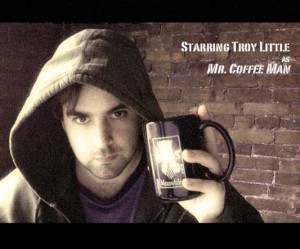
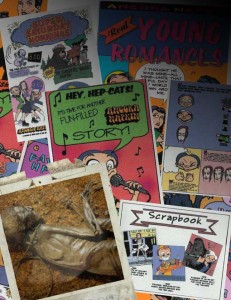
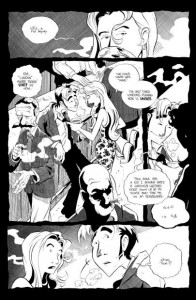
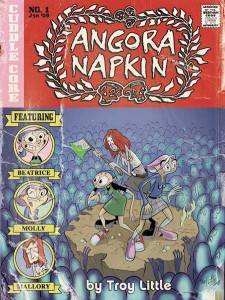
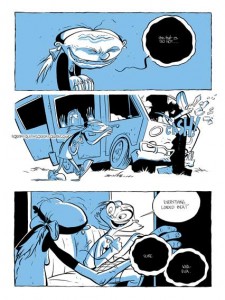
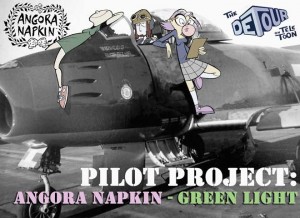
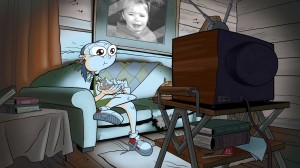
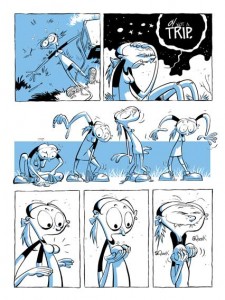
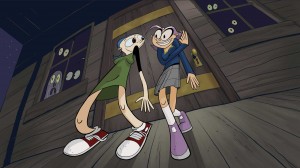
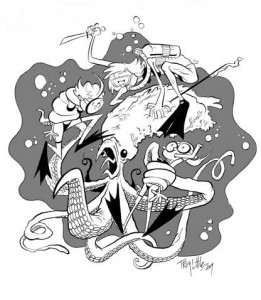
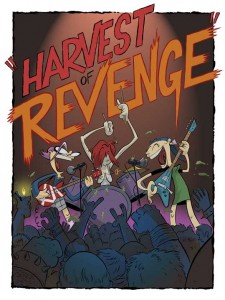
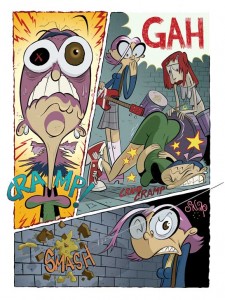


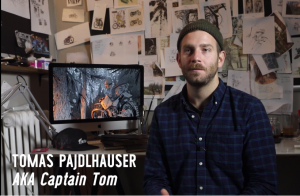
[…] and brightening your day is an interview with Eisner nominated creator Troy Little. Read it here, if you haven’t […]
Fascinating and inspiring interview! Very interesting finding out more on the nuts & bolts of the creative process and the grinding gears of the world o’ animation. Thanks for making this interview available–very cool! Best of luck, Troy! >^_^<